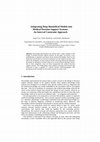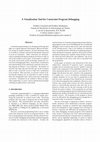Papers by Frédéric Benhamou
Disjunctions in numerical CSPs appear in applications such as Design, Biology or Control. General... more Disjunctions in numerical CSPs appear in applications such as Design, Biology or Control. Generalized solving techniques have been proposed to handle these disjunctions in a Branch&Prune fashion. However, they focus essentially on the pruning operation. In this paper, we present experimental evidences that significant performance gains can be expected by exploiting the disjunctions in the branching operation.

Lecture Notes in Computer Science, 1999
Knowledge representation has always been a major problem in the design of medical decision suppor... more Knowledge representation has always been a major problem in the design of medical decision support systems. In this paper we present a new methodology to represent and reason about medical knowledge, based on the declarative specification of interval constraints over the medical concepts. This allows the integration of deep medical models involving differential equations developed in biomedical research (typical in several medical domains) which, due to their complexity, have not been incorporated into medical decision support systems. The methodology which enables reasoning both forward and backward in time, is applied to a specific domain, electromyography. The promising results obtained are discussed to justify our future work. medical knowledge" [2], . In contrast with systems that represented causal but "shallow" relations, say between a disease and a symptom, they represent a more detailed set of pathophysiologic states and processes to explain that shallow relation.
... Constraint logic programming: selected research. ... Publication: · Book, Constraint logicpro... more ... Constraint logic programming: selected research. ... Publication: · Book, Constraint logicprogramming: selected research. MIT Press Cambridge, MA, USA ©1993 table of contents ISBN:0-262-02353-9. 1993 Book. Bibliometrics. · Downloads ...
Numerical Constraint-Satisfaction Problems (NCSPs) are stated as (in)-equalities between numerica... more Numerical Constraint-Satisfaction Problems (NCSPs) are stated as (in)-equalities between numerical functions. The properties of these functions are a most useful information, which determines the use of specialized algorithms. We propose a framework to reason on a set of function properties which integrates monotonicity and convexity, and aims at being general and extensible. Properties are seen as abstractions of the function curves, and we propose deduction rules to reason on these abstractions. We give guidelines on how this tool can cooperate with existing or customized constraint-solvers.
Abstract: IntroductionLaurent Granvilliers, Eric Monfroy, and Frederic BenhamouInstitut de Recher... more Abstract: IntroductionLaurent Granvilliers, Eric Monfroy, and Frederic BenhamouInstitut de Recherche en Informatique de Nantes (IRIN)Universite de Nantes44322 Nantes cedex 3, FranceE-mail: granvilliers@irin.univ-nantes.fr,monfroy@irin.univ-nantes.fr, benhamou@irin.univ-nantes.frIn the constraint programming community, solver cooperation is now wellknownas a concept for improving eciency and performance of constraintsolvers. Generic solvers are generally far too inecient for solving...
... Constraint logic programming: selected research. ... Publication: · Book, Constraint logicpro... more ... Constraint logic programming: selected research. ... Publication: · Book, Constraint logicprogramming: selected research. MIT Press Cambridge, MA, USA ©1993 table of contents ISBN:0-262-02353-9. 1993 Book. Bibliometrics. · Downloads ...
Journées Francophones de Programmation Logique par Contraintes, 2002

14th IEEE International Conference on Automated Software Engineering, 1999
Constraint programming is an emerging technology that offers an original approach allowing for ef... more Constraint programming is an emerging technology that offers an original approach allowing for efficient and flexible solving of complex problems. Its main advantage relies in its ability to compute with partial information expressed in terms of constraints. These constraints are monotonically accumulated during the program execution in order to restrict the problem search space. In this paper we address one of the cornerstones of this technology, namely the current lack of debugging facilities. In particular, visualization and understanding of the underlying constraint system during program executions is very important. We propose to structure this huge, flat and intricate part of the execution data in order to provide access to high level examination of its evolution. More precisely, we present a means to hierarchically organize sets of constraints in order to divide them into manageable parts while preserving computation correctness. Soundness of our method is shown, an algorithm supporting it is given, and an implemented prototype exhibiting its effectiveness is described.




Uploads
Papers by Frédéric Benhamou